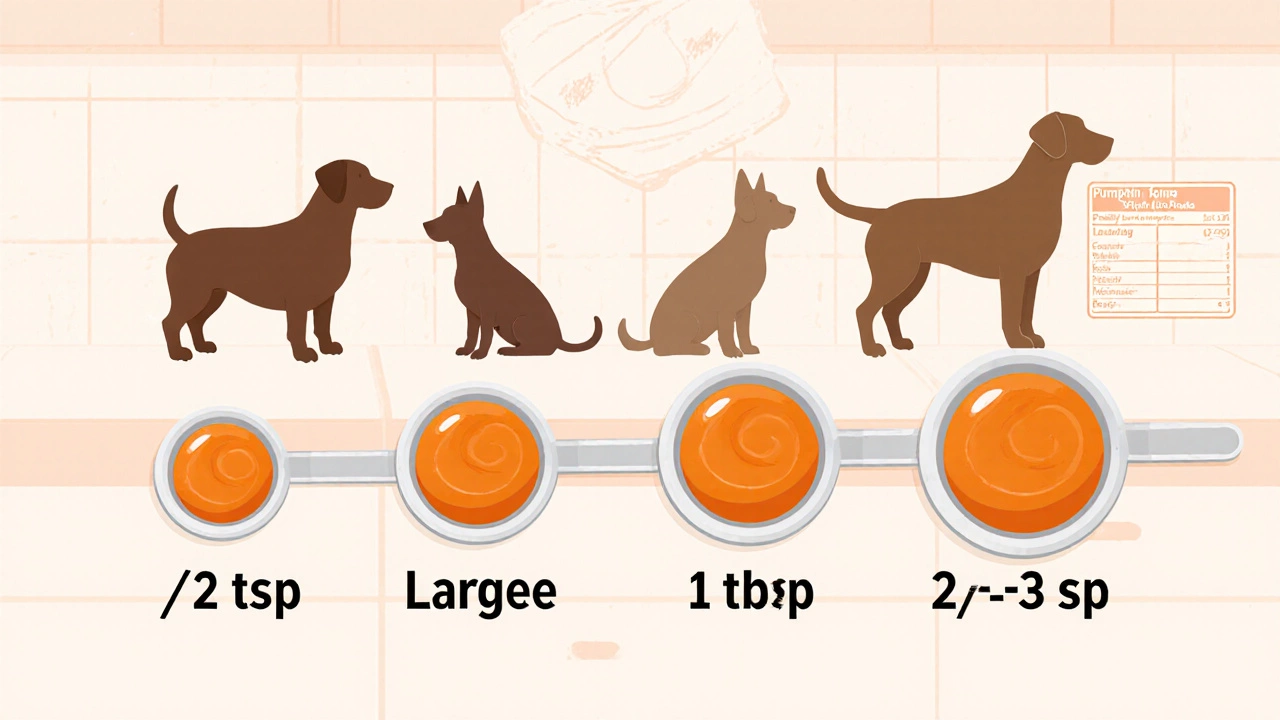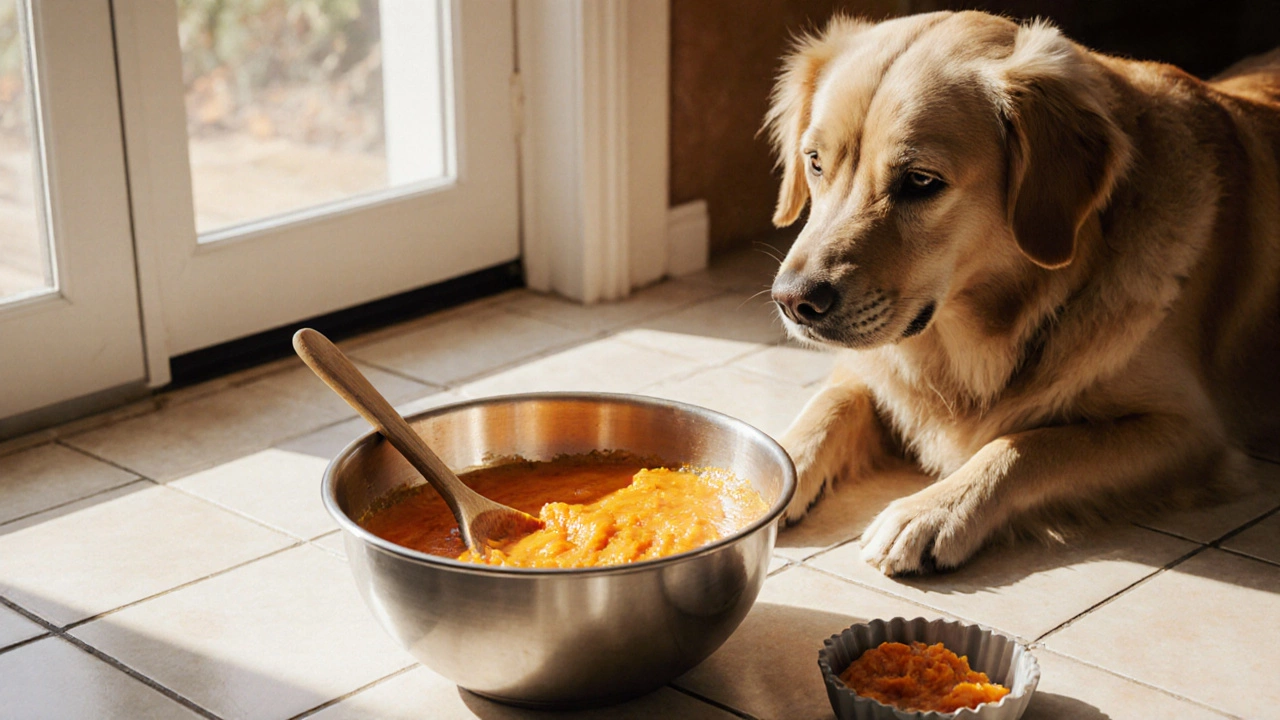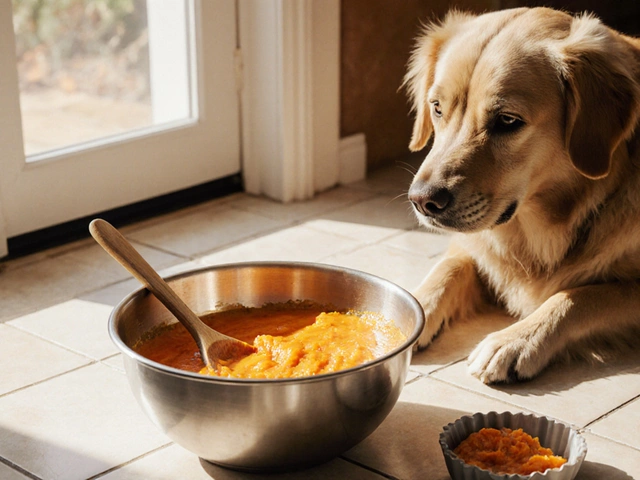Pumpkin Puree Daily Dosage Calculator
How Much Pumpkin for Your Dog?
Calculate the safe daily amount of pumpkin puree based on your dog's weight and health status.
Ever wondered if you can make pumpkin puree for dogs a part of their everyday menu? You’re not alone. Many pet parents hear about the fiber boost and the gentle tummy relief pumpkin offers, and they start wondering: is a daily spoonful safe, or could it backfire?
Pumpkin puree is a smooth, cooked, and blended pumpkin product often used as a nutritious dog supplement. It’s low‑calorie, rich in Fiber a type of carbohydrate that isn’t digested but helps move food through the gut, and packed with Vitamin A a fat‑soluble vitamin essential for vision, immune function, and skin health and Beta‑carotene the orange pigment that the body converts into Vitamin A. All of these sound great, but the real question is how they play out when you serve them every day.
Why Pet Parents Reach for Pumpkin
Before we get into the daily‑dose debate, it helps to know the common reasons owners add pumpkin to a Dog a domesticated canine companion that benefits from balanced nutrition and occasional supplements’s bowl:
- **Digestive aid** - the soluble fiber absorbs excess water in the gut, while the insoluble part adds bulk. Together they can soothe both diarrhea and constipation.
- **Weight control** - because it’s low‑calorie, pumpkin can add volume to meals without adding many calories, helping overweight dogs feel fuller.
- **Skin & coat sparkle** - Vitamin A and the antioxidants in beta‑carotene support healthy skin and a glossy coat.
- **Gentle source of nutrients** - for dogs with sensitive stomachs or food allergies, plain pumpkin offers a neutral flavor that’s rarely an allergen.
Potential Risks of a Daily Scoop
Good intentions can sometimes lead to unintended side effects. Here are the main things that can go wrong if you overdo the pumpkin:
- Excess fiber - Too much fiber can cause bloating, gas, or even diarrhea, especially in small breeds.
- Calorie miscount - While pumpkin is low‑calorie, a generous spoonful adds up. Over time, it could contribute to unwanted weight gain if not accounted for in the overall diet.
- Nutrient imbalance - Pumpkin isn’t a complete source of protein or essential fatty acids. Relying on it for “health” can mask a diet that’s missing key nutrients.
- Allergic reaction - Rare, but some dogs develop sensitivities to pumpkin or to additives in canned versions (like added sugar or spices).
How Much is Too Much? A Practical Guide
When it comes to daily pumpkin, size matters. Below is a quick reference you can print and stick on the fridge. The amounts are based on the USDA’s average fiber needs for dogs (about 2‑4 g of fiber per 100 lb of body weight) and the typical calorie content of plain pumpkin (≈ 20 kcal per ½ cup).
| Dog Weight | Suggested Amount | Calories Added |
|---|---|---|
| Under 10 lb (4.5 kg) | ½ tsp (≈ 2 g) | ~2 kcal |
| 10‑30 lb (4.5‑13.5 kg) | 1 tsp (≈ 5 g) | ~4 kcal |
| 30‑70 lb (13.5‑32 kg) | 1 tbsp (≈ 15 g) | ~6 kcal |
| 70‑100 lb (32‑45 kg) | 2 tbsp (≈ 30 g) | ~12 kcal |
| Over 100 lb (45 kg+) | 3 tbsp (≈ 45 g) | ~18 kcal |
These figures are a starting point. If your dog is very active, the extra calories may be a bonus. If they’re couch‑potatoes, stick to the lower end.

Best Ways to Serve Pumpkin Puree
Giving pumpkin isn’t just about ladling a spoonful into the bowl. A few tricks make it more appealing and safer:
- Choose pure pumpkin - Look for canned pumpkin that lists only “pumpkin” as the ingredient. Avoid pie fillings that contain sugar, spices, or added salt.
- Mix it in - Stir the puree into wet food, or blend it with a little boiled chicken broth for a tasty topping.
- Freeze into treats - pour the puree into ice‑cube trays and freeze. Each cube becomes a low‑calorie, gut‑friendly treat.
- Combine with protein - a spoonful of pumpkin over a small piece of lean meat can mask any “vegetable” taste that picky pups dislike.
When to Skip the Pumpkin
Even if pumpkin is generally safe, there are scenarios where you should hold off:
- **Existing GI issues** - If your dog is currently on medication for ulcers or inflammatory bowel disease, talk to a vet before adding any fiber source.
- **Diabetes** - Pumpkin has a modest glycemic impact. Dogs on insulin may need the extra carbs accounted for.
- **Recent surgeries** - Post‑op diets are usually prescribed; extra fiber could interfere with healing.
- **Allergy signs** - Watch for itching, ear inflammation, or gastrointestinal upset after the first few servings.
Alternative Supplements for Digestive Health
If pumpkin isn’t your cup of tea, there are other dog‑friendly options that provide similar benefits:
- Cooked sweet potato - also high in fiber and beta‑carotene, but with a sweeter taste.
- Plain canned pumpkin seed oil - offers omega‑6 fatty acids for skin health without the bulk.
- Probiotic powders - target gut flora directly, useful for chronic diarrhea.
- Ground psyllium husk - a concentrated fiber source; use sparingly.

Quick Checklist: Is Daily Pumpkin Right for Your Dog?
- Is your dog at a stable weight? ✅
- Do you have a reliable way to measure the recommended amount? ✅
- Is the pumpkin pure, with no added sugars or spices? ✅
- Has your vet approved the addition, especially if your dog has medical conditions? ✅
- Can you monitor for signs of digestive upset? ✅
If you answered “yes” to most of these, a daily spoonful is likely fine. If you’re on the fence, start with a small amount a few times a week and watch the response.
What Vets Say
Most veterinarians view pumpkin as a “functional food” - something that’s not essential but can support health when used responsibly. Dr. Samantha Lee, a small‑animal vet in Auckland, notes: “Pumpkin is a great source of soluble fiber that can help regulate stool consistency. The key is moderation and ensuring it doesn’t replace the main protein source.”
Bottom Line
Daily pumpkin puree can be a safe, low‑calorie way to boost fiber, vitamins, and digestive comfort in most dogs, as long as you stick to weight‑appropriate portions and keep an eye on the overall diet. When in doubt, consult your vet and treat the pumpkin as a supplement, not a staple.
Can I give my dog raw pumpkin instead of puree?
Raw pumpkin is tougher to digest and can cause intestinal blockage if not finely grated. Cooking and pureeing break down the fibers, making it safe and easier on the stomach.
How long does pumpkin stay fresh once opened?
Refrigerated canned pumpkin lasts about 5‑7 days. If you’ve made homemade puree, store it in an airtight container for up to 3 days, or freeze in portions for longer.
Will pumpkin help my dog lose weight?
Pumpkin adds bulk without many calories, so it can help a dog feel fuller while you reduce the overall calorie intake. It’s not a magic weight‑loss solution; a balanced diet and exercise are still essential.
My dog has diabetes - can I still use pumpkin?
Pumpkin has a low glycemic index, but it does contain natural sugars. Give only the small, vet‑approved amount and factor those carbs into your dog’s total daily intake.
What’s the difference between canned pumpkin and pumpkin puree?
Pure pumpkin typically means 100 % pumpkin with no additives. Some “pumpkin puree” brands market themselves as ready‑to‑eat for pets and are also additive‑free. Always read the label - avoid anything with sugar, spice, or sodium.





